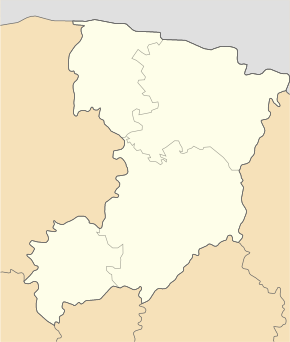Dubno
| Dubno | ||
| Дубно | ||

|
|
|
| Basic data | ||
|---|---|---|
| Oblast : | Rivne Oblast | |
| Rajon : | District-free city | |
| Height : | no information | |
| Area : | 27.04 km² | |
| Residents : | 38,208 (2006) | |
| Population density : | 1,413 inhabitants per km² | |
| Postcodes : | 35608 | |
| Area code : | +380 3656 | |
| Geographic location : | 50 ° 25 ′ N , 25 ° 45 ′ E | |
| KOATUU : | 5621600000 | |
| Administrative structure : | 1 city | |
| Mayor : | Leonid Dudko | |
| Address: | вул. Замкова 4 35600 м. Дубно |
|
| Website : | http://www.dubno-adm.rv.ua/ | |
| Statistical information | ||
|
|
||
Dubno ( Ukrainian Дубно [dubno], Russian (other pronunciation: [dubna])) is a Ukrainian city with about 38,000 inhabitants. It is located in the southwest of Rivne Oblast on the Ikwa River and is surrounded by Dubno Rajon , but is not administratively part of it. The city is located on the Ukrainian trunk road M 06 / E 40 northwest of the district capital Rivne .
The city became known through the novel Taras Bulba by Nikolai Gogol , which describes the siege of the city by the Cossacks.
history
Dubno was first mentioned in writing in 1100, and in 1498 it was granted city rights. Ruled by the Ostrogski since the 14th century , and with city rights since 1498, Dubno attracted many Jewish and Armenian settlers. In 1619 the castle was inherited by the Zasławski family . In the 19th century it was expanded into a fortress that was badly damaged in the First World War . Under the Polish administration after the World War II, the town became the seat of a powiat and the construction of a large prison began in the 1930s.
During the Second World War , after the attack on the Soviet Union , Dubno was initially defended by the Red Army against the advancing German 11th Panzer Division . After the tank battle at Dubno-Lutsk-Rivne from June 23 to 29, 1941, there was German occupation until 1944.
Dubno has belonged to Ukraine since 1945, and until 1991 it was part of the Ukrainian SSR within the Soviet Union .
Axel von dem Bussche
In October 1942, the German officer was Axel von dem Bussche (1919-1993) in Dubno witnessed a massacre of the SS to Jews . He decided to kill Adolf Hitler . In addition to Bussche, the civil engineer Hermann Gränke (1900–1986) also became an eyewitness; he later described his observations on oath at the Nuremberg Trial .
Attractions
- Dubno Castle
- Synagogue , built 1782 to 1784 (cultural monument)
- Jewish cemetery from the 16th century
Personalities
- Salomo Dubno (1738–1813), Jewish enlightenment
- Nikolai Karl von Baranoff (1825–1903), Russian lieutenant general
- Mikhail Evsejewitsch Bukinik (1872–1947), cellist, composer, music teacher and music critic
- Vyacheslav Ivanovich Sof (1889–1937), functionary, military and from 1924 to 1926 commander in chief of the Soviet naval fleet
Web links
- Dubno . In: Filip Sulimierski, Władysław Walewski (eds.): Słownik geograficzny Królestwa Polskiego i innych krajów słowiańskich . tape 2 : Derenek – Gżack . Sulimierskiego and Walewskiego, Warsaw 1881, p. 194 (Polish, edu.pl ).
- Official website





